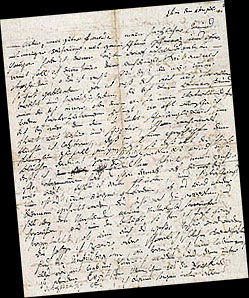
Exploring Beethoven’s Letters: Insight & Legacy
Unraveling Beethoven’s Handwritten Letters
Ludwig van Beethoven, a name synonymous with classical music, has long been celebrated for his profound symphonies, sonatas, and concertos. However, beyond his musical genius, Beethoven was also a prolific letter writer. His handwritten letters offer a unique window into his personal life, his struggles, and his creative process. This article delves into the world of Beethoven’s letters, unraveling the stories they tell and the insights they provide into one of history’s greatest composers.
The Significance of Beethoven’s Letters
Beethoven’s correspondence comprises over a thousand letters, written to family, friends, fellow musicians, and patrons. These letters, dating from his teenage years until his death, chronicle his journey from a young, ambitious musician in Bonn to a celebrated composer in Vienna. They reveal his thoughts on music, his creative struggles, and his personal relationships. Moreover, they provide a glimpse into the mind of a man who, despite losing his hearing, continued to compose some of the most beautiful music the world has ever known.
Personal Struggles and Triumphs
Perhaps the most poignant aspect of Beethoven’s letters is their reflection of his personal struggles. His hearing loss, which began in his late twenties, is a recurring theme. In a famous letter known as the “Heiligenstadt Testament,” written in 1802, Beethoven expressed his despair and isolation due to his increasing deafness. Yet, these letters also demonstrate his resilience and determination to continue composing, offering a powerful testament to his unyielding spirit.
Beethoven’s letters also shed light on his relationships and his often turbulent personal life. His letters to family members, especially his brothers, reveal the complexities of his family dynamics. His correspondence with patrons and musicians provides insights into the practical aspects of his career, including negotiations over compositions and performances.
Insights into the Creative Process
Beethoven’s letters are not just personal reflections; they are also a treasure trove of information about his creative process. Through his correspondence, we can trace the development of some of his most famous works. For instance, his letters to publishers and friends often mention his current projects, giving us a timeline of his compositions. Additionally, his discussions about specific musical pieces provide a rare glimpse into the mind of a genius at work, revealing how he approached composition and dealt with the challenges of bringing his musical ideas to fruition.
Beethoven and His Contemporaries
The letters also illuminate Beethoven’s relationships with other prominent figures of his time. Correspondence with fellow composers, musicians, and influential members of society paints a vivid picture of the cultural and social circles in which Beethoven moved. These interactions highlight the respect and admiration he commanded among his peers, as well as the rivalries and friendships that shaped his career.
Preservation and Study of the Letters
The preservation of Beethoven’s letters is a story in itself. After his death, his letters were scattered among various holders, including friends, family, and collectors. Over the years, musicologists and historians have painstakingly collected, authenticated, and published these letters, providing invaluable resources for understanding Beethoven’s life and work. The study of these letters continues to evolve, with ongoing research shedding new light on various aspects of Beethoven’s life.
Challenges in Interpreting the Letters
Interpreting Beethoven’s letters is not without its challenges. The composer’s handwriting was notoriously difficult to read, and he often wrote in a highly personal and idiosyncratic style. Additionally, translating these letters from German to other languages poses its own set of difficulties, as nuances and subtleties can be lost in translation. Nevertheless, the effort to understand these letters is a testament to their enduring value and the continuing fascination with Beethoven’s life and work.
Beethoven’s Legacy Through His Letters
Beethoven’s letters do more than just provide a biographical sketch; they enrich our understanding of his legacy. They show a man deeply committed to his art, struggling against personal and professional challenges, yet unwavering in his dedication to music. This humanizes Beethoven, transforming him from a mythical figure of classical music into a relatable individual. His vulnerabilities, joys, frustrations, and triumphs, as expressed in these letters, resonate with readers and musicians alike, making his music even more profound and impactful.
Selected Letters: Windows into Beethoven’s World
Among the vast collection of Beethoven’s letters, certain ones stand out for their emotional depth and historical significance. The “Heiligenstadt Testament,” already mentioned, is a heart-wrenching account of his despair over his deafness. His letters to his “Immortal Beloved,” whose identity remains a subject of speculation, reveal a passionate and deeply romantic side of the composer. Letters to his patrons, such as Archduke Rudolph and Countess Marie Erdödy, show his reliance on and gratitude towards his supporters. Each of these letters adds a different hue to the portrait of Beethoven, the man and the artist.
Impact on Music History and Culture
The study of Beethoven’s letters has significantly influenced both music history and broader cultural understanding. By providing context to his compositions, these letters have shaped the way musicologists and performers approach his works. They have also influenced the public’s perception of Beethoven, contributing to the enduring fascination with his life and music. His letters are not just historical documents; they are an integral part of the cultural heritage that surrounds one of the greatest composers of all time.
Conclusion
Ludwig van Beethoven’s handwritten letters offer a remarkable insight into the life and mind of a musical genius. They reveal his struggles, his relationships, and his creative genius, painting a complex portrait of a man who changed the course of musical history. As we continue to study these letters, we gain a deeper appreciation for Beethoven’s music and a more profound understanding of the human experience behind it. In unraveling Beethoven’s handwritten letters, we unravel a part of ourselves, discovering the timeless power of human expression through art.